Abstract
The creaming effects, mechanical properties and microstructures of processed cheeses were investigated under different emulsifying conditions using a rapid visco-analyzer, and the changes in protein network related to the creaming effect and the occurrence of yielding points were discussed. The higher stirring speed affected the fat globules to be smaller, and gave the processed cheese more firmness at fixed stirring time. The longer stirring time caused the protein network to become fine-stranded. A fine-stranded structure promoted the creaming effect, and hence the formation of yielding point in the mechanical properties. The emulsifying salts had active effects on the creaming effect and mechanical properties at longer stirring time. The fine-stranded structures were shown in the cases of a binary mixture of polyphosphate and disodium phosphate (PDSP), polyphosphate (PP), and trisodium citrate (TSC). Monophosphate (MP) showed the lowest ability to alter the protein network, but was assisted at the higher stirring speed.
The image of the effects of emulsifying conditions on microstructures of processed cheeses.
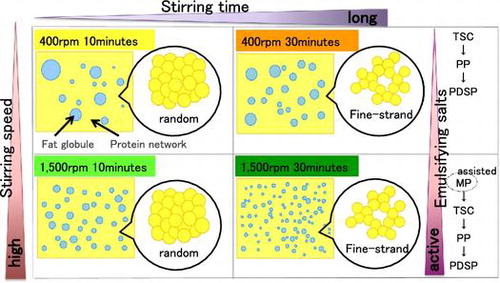
Processed cheese is a popular and traditional gel-like dairy product consumed in many countries. Processed cheese was originally developed to extend the shelf life of natural cheese and to find additional usage avenues for unsold natural cheese. Increasingly, researchers have focused on more versatile end-use applications of processed cheese. To this end, they have investigated the mechanical properties contributing to food texture [Citation1–6].
In a practical processed-cheese manufacturing operation, research samples are usually produced at the pilot scale to reduce the manufacturing time and cost of an as-yet untested product. Recently, there has been interest in developing small-scale processed cheese manufacturing to facilitate the rapid and inexpensive assessment of experimental variables. Processed cheese can be manufactured on small scales using the Rapid Visco Analyzer (RVA). After standardizing the RVA temperature, mixing speed, and time of manufacture, the properties of the RVA-produced cheeses and those made in a pilot-scale twin-screw cooker are well-correlated [Citation7–9].
In the RVA, processed cheese is mainly prepared by mixing the raw cheese, emulsifying salts, water, and limited amounts of additional ingredients, heating to melt the mixture, and stirring the mixture in a reaction container. The most important part of the process is heating for an appropriate time with continuous stirring (emulsifying process) until a homogeneous mass is formed. The emulsifying process enhances the qualities of the processed cheese, especially its viscosity and mechanical properties. The continuous increase in viscosity during cooking is called the creaming effect, and the continuous cooking itself is called creaming. The creaming effect can also be induced by cooling and storage, which essentially change the protein network [Citation10]. In processed-cheese manufacturing, creaming affects the sizes of the milk fat globules and the protein network structure, thereby influencing the viscosity of the melted cheese or the firmness of the final product [Citation11]. Several researchers have investigated how the creaming effect alters the viscosities or mechanical properties of processed cheese [Citation5,10,11]. The creaming effect is primarily a protein-based interaction induced by structural changes in the protein network, regardless of the presence of fat [Citation12].
The creaming process depends not only on the speed and time of stirring, but also on the emulsifying salts, which improve the emulsifying capacity of cheese proteins during the processing [Citation13]. The emulsifying salts detach the calcium ions from the cheese matrix and replace them with sodium ions. This ionic exchange converts the insoluble calcium paracaseinate into sodium paracaseinate, which is more soluble and functions as an emulsifier and stabilizer in the melt [Citation14–19]. The effects of emulsifying salts (applied singly or in combination) on the production of model processed cheeses are well described in the available literature [Citation15,20–26]. In contrast, how various emulsifying salts affect the creaming effect, and the structures of the protein network contributing to this effect, remain unclear.
The present work investigates the creaming effect, mechanical properties and microstructure of processed cheese under various emulsifying conditions, and discusses the types of protein network that induce the creaming effect and yielding points. This study will be beneficial to use the proper emulsifying conditions to control the protein network contributing to the viscosities and the mechanical properties of processed cheese effectively, as well as help adjust the quality attributes in processed cheese.
Materials and methods
Materials
The raw cheeses of Gouda (moisture 40%, protein 26%, fat 29%, ash 4%, carbohydrate 1%) and Cheddar (moisture 35%, protein 26%, fat 34%, ash 4%, carbohydrate 1%) were obtained from Megmilk Snow Brand Company, Ltd. (Tokyo, Japan). Sodium polyphosphate, disodium phosphate, monophosphate, trisodium citrate, and sodium bicarbonate were purchased from ICL Japan Ltd. (Tokyo, Japan). 50% Glutaraldehyde (TAAB) and 2% osmium tetraoxide (Chiyoda Pure Chemical Ind., Ltd., Japan) were used. The other chemicals were of special grade. Distilled water was used in all processed cheese preparations.
Processed cheese preparation
The processed cheeses were manufactured in triplicate in a Rapid Viscosity Analyzer (RVA-4, Newport Scientific Ltd., Australia). As the manufacturing process, we followed Metzger et al. [Citation7] with the following changes.
The stirring speeds and times of the emulsifying conditions were varied as follows: 400 rpm for 10 min (A); 400 rpm for 30 min (B); 1500 rpm for10 min (C); and 1500 rpm for 30 min (D). For the short stirring time, the temperature of heating block was increased from 50 to 90 °C in 3 min, then held at 90 °C for 7 min. For the long stirring time, it was raised from 50 to 90 °C in 3 min, then held at 90 °C for 27 min. As the emulsifying salts, we prepared a binary mixture of polyphosphate with disodium phosphate (PDSP), polyphosphate (PP), monophosphate (MP), and trisodium citrate (TSC). The final moisture content was controlled at 45–46% (wet basis) by adding distilled water. The formulation of the processed cheese preparation is given in Table . The amount of sodium bicarbonate was adjusted to meet the target pH (5.8–5.9). After cooking, the melted cheese was transferred to a zipped bag (W70 × D100 mm), and shaped to a height of 5 mm. The bag was placed in ice-cold water for cooling. The samples were stored at 5 °C.
Table 1. Formulation of the processed cheese preparation.
Fracture test
The fracture test was measured with a creep-meter (RE2-33005s, Yamaden Ltd., Japan) as described in Fu et al. [Citation27]. The samples were shaped into cylinders using a straw of diameter 10 mm and height 5 mm. The samples were broken by a disc plunger (of diameter 40 mm) with a load cell of 20 N and a speed of 1.0 mm/s. The stress–strain curves of the samples were drawn by fracture test analysis software (Ver. 2.0). Each sample was measured at least 10 times.
Confocal laser scanning microscopy
The protein and fat phases were stained with 2.5 μlL Rhodamine B solution (2.5 μg/mL) (Nakarai Tesque, Inc., Japan) and 2.5 μlL BODIPY500/510 c4, c9 (1 mM) (Life Technologies Ltd., Japan) after sectioning, respectively. Sectioned samples were cut to a thickness of 1 mm, and examined with a 100× oil immersion objective lens by an FV1000D inverted confocal laser scanning microscope (Olympus Corp., Japan). To ensure that the fats and proteins were detected at fluorescent wavelengths, we applied an Ar laser with an excitation line of 488 nm and a He–Ne laser with an excitation line of 559 nm.
Scanning electron microscopy analysis
The samples were cut into thin strips (approximately 1 × 1 × 5 mm) with a blade. The double chemical fixation, dehydration and critical point drying of the samples were carried out using the methods described in Moriguchi et al. [Citation28]. The processed samples were affixed to a microscope stage with carbon tape. An evaporation coating was applied by an osmium plasma machine (NL-OPC80N, Filgen Inc., Japan). The processed samples were observed by scanning electron microscope (JSM-6700F, JEOL Ltd., Japan) with an accelerating voltage and irradiation current of 3 kV and 8 μA, respectively.
Statistical analysis
The differences among the fracture properties of the samples were evaluated by one-way analyses of variance using IBM SPSS Statistics Ver. 21 software (IBM Japan, Ltd.). Significance was defined as p < 0.05.
Results and discussion
Rapid viscosity analysis
Figure shows the effects of stirring speed and time on the viscous properties of the processed cheese. The viscosity of A (400 rpm, 10 min) was unstable, and there was no increase in viscosity, meaning that no creaming effect occurred under the low-speed, short-time condition. The viscosity of C (1500 rpm, 10 min) was stable at an early time, and started to increase slowly during the processing because of high stirring speed (creaming sufficiently). In samples B (400 rpm, 30 min) and D (1500 rpm, 30 min), the viscosity curves began increasing in the latter half of the plots, indicating that a sufficiently long stirring time promotes the creaming effect. The viscosity of D increased at an especially early time, apparently because of the high stirring speed. Lee et al. [Citation12] reported that continuous cooking can increase the apparent viscosity of processed cheese. They surmised that the creaming effect arises from the changed viscosity profile during cooking. The present study shows that the stirring speed also affects the viscosity of processed cheese at shorter stirring times.
Figure 1. Viscosity curves of processed cheese at different stirring speeds and times. The emulsifying salt is PDSP. (a) 400 rpm, 10 min; (b) 400 rpm, 30 min; (c) 1500 rpm, 10 min; (d) 1500 rpm, 30 min. Pink line is the temperature profile.
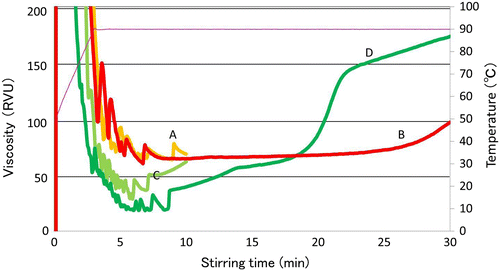
Figure shows the effects of different emulsifying salts on the creaming effect of processed cheeses. The stirring time was fixed at 30 min, and the stirring speed was varied as 400 and 1500 rpm. At the lower stirring speed (Figure (a)), the viscosity was most increased in the PDSP sample. PP enhanced the viscosity to a lesser extent, but the viscosity of the MP sample remained low with no increase, meaning that the MP did not induce the creaming effect. The TSC sample exhibited an inconspicuous increase in viscosity. At the higher stirring speed (Figure (b)), the samples of PDSP, PP, and TSC showed quite increased viscosities. Especially, MP initiated a non-monotonical increase in viscosity, different from the behavior at 400 rpm.
Figure 2. Viscosity curves of processed cheeses fortified with different emulsifying salts. (a) 400 rpm, 30 min; (b) 1500 rpm, 30 min. Red line is the temperature profile.
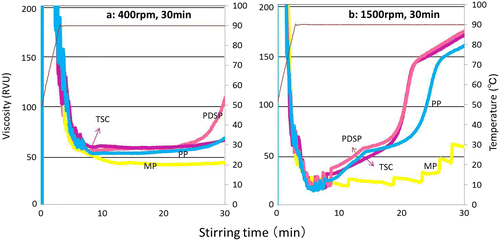
According to previous researches [Citation18,22], the degree of casein dispersion within a system of processed cheeses closely relates to the ability of phosphates to bind calcium into complexes. The calcium- binding ability decreases in the following order: long-chain polyphosphates, triphosphates, diphosphates and monophosphates. The different effects of emulsifying salts on the viscosities of processed cheese could be explained by changes in the salt bonds, which would alter the dissociation of colloidal calcium phosphate (CCP). Weiserova et al. [Citation22] reported that MP has the lowest ability to exchange ions, it can less ably influence the viscosity than the long-chain phosphate salts, which are more capable of binding calcium ions. Therefore, the viscosity in the present work is more easily raised in long-chain phosphate salts (PDSP and PP) than in MP. The functioning of TSC and phosphate salts on casein proteins occurs by different mechanisms. According to Mizuno et al. [Citation13], TSC does not apparently work as a cross-linking agent. Instead, TSC chelates Ca from CCP to form soluble complexes. The loss of CCP from casein proteins increases the dispersion of casein micelles, which might explain the inconspicuous viscosity increase in the TSC sample.
Fracture test
Figure presents the fracture stress–strain curves of the processed cheeses under different emulsifying conditions. In the PDSP and PP samples, raising the stirring time to 30 min (B and D) increased the firmness (the stress at 20%), and yielding points occurred on the stress/strain curves. At the 10-min stirring time (A and C), the firmness was lower and yielding points were absent, implying that a longer stirring time enhances the firmness and allows the yielding points to form. In TSC, high firmness and yielding points were obtained under Condition D (similarly to PDSP and PP). Under Condition B, the firmness was reduced but the stirring time was apparently sufficient to form yielding points. In MP, the firmness was more affected by the stirring speed than the stirring time. Under Conditions C (1500 rpm, 10 min) and D (1500 rpm, 30 min), the rising stress was higher than under A (400 rpm, 10 min) and B (400 rpm, 30 min). Overall, the MP samples were softer than the PDSP, PP, and TSC samples, consistent with the results of Weiserova et al. [Citation22] In their study, the firmness of the samples increased with increasing proportion of long-chain phosphates in a given binary mixture of PDSP. Sadlikova et al. [Citation29] also found that the firmness increased until the content of long-chain polyphosphates reached 50% in a binary mixture with diphosphate. The firmness of processed cheese is probably related to the microstructure of the protein network. When this network is changed by continuous stirring or adding emulsifying salts, the firmness is enhanced and yielding points are formed. To confirm the above-mentioned hypothesis, we examined scanning electron micrographs of the samples.
Figure 3. Fracture stress–strain curves of processed cheeses under different emulsifying conditions. (a) 400 rpm, 10 min; (b) 400 rpm, 30 min; (c) 1500 rpm, 10 min; (d) 1500 rpm, 30 min. Arrows indicate the yielding points. Error bars denote the standard deviations of the stress under 20% strain. Different lower-case letters indicate significant differences among the samples (p < 0.05).
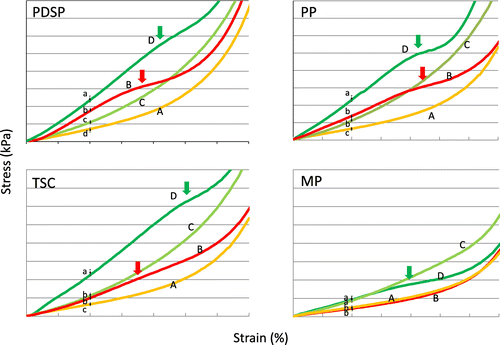
Scanning electron microscopy
The sizes of the eliminated fat globules in the processed cheeses at different stirring times and speeds were observed in scanning electron micrographs. The fields of the fat globules in the processed cheeses were confirmed in confocal laser scanning micrographs (Figure ). The size of the fat globules reduced at the higher stirring speed (Conditions C and D), but was little affected by the stirring time (at fixed stirring speed). This verifies that the sizes of the fat globules are more affected by stirring speed than stirring time.
Figure 4. Scanning electron micrographs and confocal laser scanning micrographs of the fat globules in cheeses processed at different stirring speeds and times. The emulsifying salt is PDSP. Green and red fields highlight the fat and protein regions with a 100× oil immersion objective, respectively. Scale bars are 10 μm.
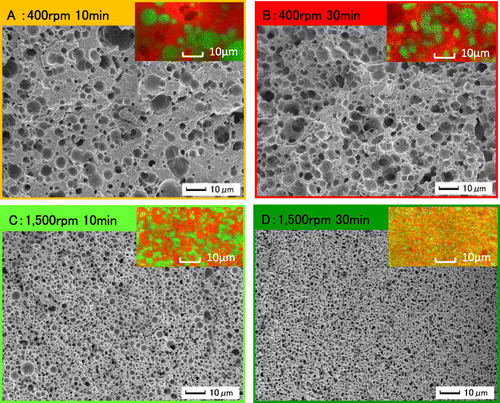
Figure shows the microstructures of the protein networks at high magnification. After longer stirring time (Conditions B and D), fine strands developed in the protein network. In contrast, the samples stirred for 10 min (Conditions A and C) showed mainly random structures. As reported by Lee et al. [Citation12], the proteins in a cheese network or rennet casein micelles are dispersed during cooking. As the cooking continues, the dispersed proteins re-associate into a protein network, increasing the apparent viscosity. In the current work, the fine-stranded structure in the protein network was considered to arise from continuous cooking over a long stirring time. This fine-stranded structure might be the reason for the increased viscosity and the creaming effect. The yielding points under Conditions B and D, observed in the fracture stress–strain curves, were also attributed to this fine-stranded structure.
Figure 5. Scanning electron micrographs of the protein networks in cheeses processed at different stirring speeds and times. The emulsifying salt is PDSP. Arrows indicate the fields containing fine-stranded structures. Magnification: 50,000×. Scale bars are 100 nm.
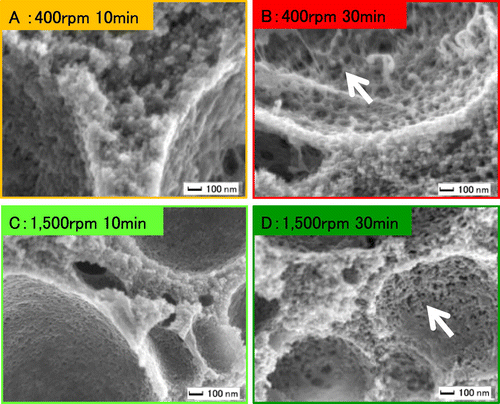
The protein network changes induced by the emulsifying salts should emerge during the creaming process. Figure shows the microstructures of the protein network in samples processed in different emulsifying salts. Fine-stranded structures appeared in the PDSP, PP, and TSC samples, but were absent in the MP sample (Figure (a)). In the past literatures [Citation18,22], it was known that casein fractions in cheese form a fine-structured three-dimensional network in which they are connected by means of calcium bridges, and the long-chain salts (PDSP and PP) are more capable of replacing calcium ions with sodium ions than MP. Besides, TSC appears to improve protein dispersion by chelating Ca and forming soluble complexes [Citation13]. In the present study, the fine-stranded structures appeared in the PDSP, PP, and TSC samples could illustrate that PDSP, PP, and TSC assisted the crosslink caseins in the emulsifying system than MP. On the other hand, at the higher stirring speed (1500 rpm), MP also developed a fine-stranded structure (Figure (b)). It explained why MP had the non-monotonical viscosity in the case of 1500 rpm in Figure . We inferred that although MP has the poor ability of replacing calcium ions, the higher stirring speed could promote the dissociation of CCP, and assist MP to function on the protein-dispersal as a role of emulsifying salt. Because of the combined action of the higher stirring speed and the poor emulsifying ability of MP, the viscosity showed the non-monotonical increase.
Figure 6. Scanning electron micrographs of the protein networks in cheeses processed in different emulsifying salts. (a) 400 rpm, 30 min; (b) 1500 rpm, 30 min. Arrows indicate the fields containing fine-stranded structures. Magnification: 50,000×. Scale bars are 100 nm.
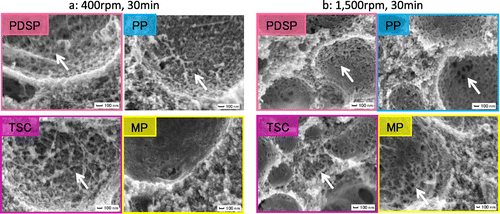
According to the past literatures, Lee et al. [Citation12] verified that the “creaming effect” (viscosity increase) was primarily a protein-based interaction, which took place with or without the presence of fat. During creaming, the changes in caseins (e.g. dispersed or re-associated) led to the changes in the protein network. In addition, Kawasaki [Citation10] mentioned that if the structural change in processed cheese was caused by creaming, the changes in the viscosity and mechanical properties of processed cheese might also cause by the structural changes. Based on the current results (Table ), we can relate the emulsifying conditions to the creaming effect (increased viscosity), yielding point, and microstructural changes in the processed cheese samples. The emulsifying conditions influenced the creaming effect and mechanical properties of the processed cheese mainly by changing its protein network. The fine-stranded nature of the protein network developed over a long stirring time rather than a high or low stirring speed during cooking. This fine-stranded structure was considered to increase the viscosity, and form yielding points in the mechanical properties. Also, further quantitative data are indispensable to prove the possibility of the microstructure relate to the viscous properties or mechanical properties of the processed cheese. Conversely, higher stirring speed (rather than longer stirring time) reduced the size of the fat globules. If the stirring time is adequate, different emulsifying salts exhibit different functionalities in processed cheese. At the shorter stirring time, the functions of the emulsifying salts were deficient or absent. The PDSP, PP, and TSC salts appeared to enhance the development of fine-stranded structures, and promoted the creaming effect during cooking. MP showed limited ability to alter the protein network, and was activated only at high stirring speed.
Table 2. Summary for changes in creaming effect, yielding point, and microstructure of processed cheeses under emulsifying conditions.
Conclusions
In the current study, increasing the stirring speed reduced the sizes of the fat globules. After a sufficiently long stirring time, the protein network became fine-stranded, which was considered to relate to the creaming effect, the firmness, and the yielding points. Under the tested emulsifying conditions, the PDSP achieved higher performance than the other emulsifying salts. This result confirms that the creaming effect and mechanical properties of processed cheese can be effectively controlled by ensuring the proper emulsifying conditions.
Author contributions
Yurika Watanabe, Hayaka Satoh, Keita Inoue, Natsumi Moriguchi, and Wei Fu performed the experiments. Kazunao Fusa, Yuya Yanagisawa, and Takaaki Mutoh from Megmilk Snow Brand Company, Ltd. provided the materials and joined discussions. Wei Fu and Takashi Nakamura wrote and edited the paper.
Disclosure statement
No potential conflict of interest was reported by the authors.
References
- Kapoor R, Metzger LE. Process cheese: technological aspects – a review. Compr Rev Food Sci Food Saf. 2008;7:194–214.10.1111/j.1541-4337.2008.00040.x
- Solowiej B, Cheung IWY, Li-Chan ECY. Texture, theology and meltability of processed cheese analogues prepared using rennet or acid casein with or without added whey proteins. Int Dairy J. 2014;37:87–94.10.1016/j.idairyj.2014.03.003
- Giri A, Kanawjia SK, Rajoria A. Effect of phytosterols on textural and melting characteristics of cheese spread. Food Chem. 2014;157:240–245.10.1016/j.foodchem.2014.01.127
- Lee SK, Klostermeyer H, Anema SG. Effect of fat and protein-in-water concentrations on the properties of model processed cheese. Int Dairy J. 2015;50:15–23.10.1016/j.idairyj.2015.06.001
- Sharma P, Munro PA, Dessev TT, et al. Shear work induced changes in the viscoelastic properties of model Mozzarella cheese. Int Dairy J. 2016;56:108–118.10.1016/j.idairyj.2016.01.010
- Shabani J, Sarfarazi M, Mirzaei H, et al. Influence of the sunflower oil content, cooking temperature and cooking time on the physical and sensory properties of spreadable cheese analogues based on UF white-brined cheese. Int J Dairy Technol. 2016;69:576–584.10.1111/idt.2016.69.issue-4
- Metzger LE, Kapoor R, Rosenberg LA, et al. RVA: process cheese manufacture. Aust J Dairy Technol. 2002;57(2):136.
- Kapoor R, Lehtola P, Metzger LE. Comparison of pilot-scale and rapid visco analyzer process cheese manufacture. J Dairy Sci. 2004;87:2813–2821.10.3168/jds.S0022-0302(04)73409-8
- Kapoor R, Metzger LE. Small-scale manufacture of process cheese using a rapid visco analyzer. J. Dairy Sci. 2005;88:3382–3391.10.3168/jds.S0022-0302(05)73022-8
- Kawasaki Y. Influence of ‘creaming’ on the properties of processed cheese and changes in the structure of casein during cheese making. Milchwissenschaft-Milk Sci Int. 2008;63:149–152.
- Saitou T, Dousako S, Igoshi K. Process cheese. The contemporary cheese. Science. 2010;211–234.
- Lee SK, Buwalda RJ, Euston SR. Changes in the rheology and microstructure of processed cheese. Lebensm -Wiss U-Technol. 2003;36:339–345.10.1016/S0023-6438(03)00012-4
- Mizuno R, Lucey JA. Effects of emulsifying salts on the turbidity and calcium-phosphate–protein interactions in casein micelles. J Dairy Sci. 2005;88:3070–3078.10.3168/jds.S0022-0302(05)72988-X
- Gupta SK, Karahadian C, Lindsay RC. Effect of emulsifier salts on textural and flavor properties of processed cheese. J Dairy Sci. 1984;67:764–778.10.3168/jds.S0022-0302(84)81367-3
- Lu Y, Shirashoji N, Lucey JA. Effects of pH on the textural properties and meltability of pasteurized process cheese made with different types of emulsifying salts. J Food Sci. 2008;73:E363–E369.10.1111/j.1750-3841.2008.00914.x
- Shirashoji N, Jaeggi JJ, Lucey JA. Effect of sodium hexametaphosphate concentration and cooking time on the physicochemical properties of pasteurized process cheese. J Dairy Sci. 2010;93:2827–2837.10.3168/jds.2009-2960
- Wang F, Zhang X, Luo J, et al. Effect of proteolysis and calcium equilibrium on functional properties of natural cheddar cheese during ripening and the resultant processed cheese. J Food Sci. 2011;76:E248–E253.10.1111/j.1750-3841.2011.02085.x
- Bunka F, Doudova L, Weiserova E, et al. The effect of different ternary mixtures of sodium phosphates on the hardness of processed cheese spreads. Int J Food Sci Technol. 2012;47:2063–2071.10.1111/ijfs.2012.47.issue-10
- Hougaard AB, Sijbrandij AG, Varming C, et al. Emulsifying salt increase stability of cheese emulsions during holding. LWT-Food Sci Technol. 2015;62:362–365.10.1016/j.lwt.2015.01.006
- Guinee TP, Caric M, Kalab M. Pasteurized processed cheese and substitute/imitation cheese products. Cheese: Chem Phys Microbiol. Volume 2: Major Cheese Groups. 2004;349–394.
- Dimitreli G, Thomareis AS. Instrumental textural and viscoelastic properties of processed cheese as affected by emulsifying salts and in relation to its apparent viscosity. Int J Food Prop. 2009;12:261–275.10.1080/10942910802256164
- Weiserova E, Doudova L, Galiova L, et al. The effect of combinations of sodium phosphates in binary mixtures on selected texture parameters of processed cheese spreads. Int Dairy J. 2011;21:979–986.10.1016/j.idairyj.2011.06.006
- Mizuno R, Lucey JA. Properties of milk protein gel formed by phosphates. J Dairy Sci. 2007;90:4524–4531.10.3168/jds.2007-0229
- Awad RA, Abdel-Hemid LB, El-Shabrawy SA, et al. Texture and microstructure of block type cheese with formulated emulsifying salt mixture. Lebensm -Wiss U-Technol. 2002;35:54–61. 10.1006/fstl.2001.0828
- Awad RA, Abdel-Hamid LB, El-Shabrawy SA, et al. Physical and sensory properties of block processed cheese with formulated emulsifying salt mixture. Int J Food Prop. 2004;7:429–448.10.1081/JFP-200032934
- Guinee TP. Salting and the role of salt in cheese. Int J Dairy Technol. 2004;57:99–109.10.1111/idt.2004.57.issue-2-3
- Fu W, Nakamura T. Explaining the texture properties of whey protein isolate/starch co-gels from fracture structures. Biosci Biotechnol Biochem. 2017;81(4):839–847.10.1080/09168451.2017.1282812
- Moriguchi N, Mutoh A, Nakamura T. Analysis of the relationship between structure and fracture property on three-component gel with egg white protein, agar and curdlan in the base of each of two-component-gels. J Japn Soc Food Sci Technol. 2013;60:397–406.10.3136/nskkk.60.397
- Sadlikova I, Bunka F, Budinsky P, et al. The effect of selected phosphate emulsifying salts on viscoelastic properties of processed cheese. Food Sci Technol. 2010;43:1220–1225.
